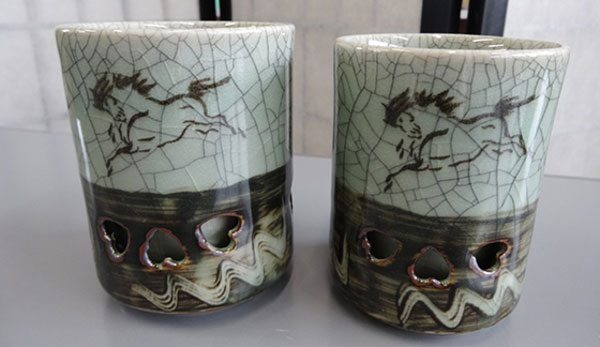
- Ceramic
- Fukushima
Obori-soma ware Obori soma yaki
Contrast of the strong blue
and the simple and soft whole taste
Description
What is Obori-soma ware ?
Obori-soma ware (called Obori-soma yaki in Japanese) is a form of porcelain produced around the town of Namie in Fukushima prefecture. This craft uses blue porcelain enamel which is made from locally collected grindstone.
The distinctive feature of Obori-soma ware is its pattern of blue fissures. On a glassy surface of celadon* porcelain glaze, these blue cracks cover the entire piece. A difference in the shrinkage rate between the raw materials and enamel causes cracks to occur when baking. At that time, a beautiful cracking sound can be heard. Then, pictures that depict the sacred horses revered by the former Soma domain (located in eastern Fukushima prefecture) are hand-drawn on the pottery. The craft is double-fired, so the inner layer of Obori-soma ware insulates hot liquids for a long time, while the outer shell prevents anyone from burning their hands. This double-firing technique is not seen in any other type of porcelain and is performed with user-friendliness of the product in mind.
*Celadon or seihakuji refers to a glaze with mixed subtle color gradations of icy, bluish white.
History
Obori-soma ware is said to have originated at the beginning of the Edo period (1603-1868) when Kyukan HANGAI, a warrior of the Nakamura domain (modern day Fukushima prefecture), discovered potter's clay in the Obori region of what is today the town of Namie, and ordered his manservant to produce pottery for his daily use. While the Soma Koma-ware produced near Nakamura Castle, city of Soma, was gifted to the feudal lord, Obori-soma ware also became popular with the masses as daily tableware. At that time, the Nakamura domain was encouraging the production of ceramics and porcelain as specialty products. In the latter part of the Edo period more than a hundred pottery operations were created, most of which prospered. The market extended from Hokkaido to the whole of Kanto and the ceramics industry underwent large expansion.
As the Meiji period began (1868-1912), the abolition of feudal domains and the introduction of prefectures led to the abolition of the Nakamura domain, which meant that the domain's patronage of Obori-soma ware ended and by the Taisho period (1912-1926) the number of pottery operations had dropped to thirty.
The Second World War caused production to decline, but today there are twenty five pottery businesses enthusiastically producing Obori-soma ware with the traditional techniques.
General Production Process
- 1. Molding
The first step is molding. Obori-soma ware is mainly molded with a lathe. In order to make a double-layered heating structure, the dimensions and shape of what will become the interior and exterior must be taken into account.
- 2. Shaving
Pieces that are still in a half-dried state have the foot or exterior planed depending on the product that is being produced. Also the pieces are decorated using techniques like a "jumping plane". The jumping plane is when a spatula-shaped hand planing tool is used to apply scratch-like patterns to the surface while the article is rotating on a lathe.
The inner item is placed inside the outer piece, and the cast is completed by pasting the mouth of the vessel.
- 3. Coloring of unglazed pottery
Half-dried cast pieces are colored with hananuki (flower plucking), mud coating, or chrysanthemum pattern application depending on what the product will become. Once the articles are completely dried, they are also engraved.
A red color is added with an iron containing mud called sarupo. There is a heart-shaped decoration which is called plover or shorebird.
- 4. Drying
Next is the drying process. Drastic drying causes cracks or warping, so pieces are first dried in the shade before being dried under sunlight.
- 5. Bisque firing
Once dried, the pieces are fired in a kiln at a temperature of 900 to 950℃ (about 1652 to 1742℃). Bisque firing refers to the initial heating at high temperature inside a kiln or furnace, before any glaze is applied.
- 6. Undercoating
Items that have been through the bisque firing process have improved water absorbency. Then they are given an undercoating with paint consisting of an iron and cobalt compound known as asbolite. The typical picture is of a running horse, but there are also subjects like mountains, rivers, pine, bamboo, and plum.
- 7. Glazing
Enamel is applied to the pottery by techniques of dipping, rotating, and pouring.
- 8. Glaze firing
Articles coated with enamel are placed inside the kiln, and glaze firing is carried out at a high temperature of around 1250 to 1300℃ (about 2282 to 2372℉).
- 9. Overcoating
Some pieces are sold as products once the glaze firing has finished, but others have an overcoating applied.
- 10. Dyeing
Finally, in order to make the crack pattern in the entire piece stand out, ink is applied and wiped off with a cloth.
Where to Buy & More Information
Aizu Machikata Densyokan
-
Address
-
Tel.+81-242-22-8686
-
ClosedMondays (open if Monday is holiday and closed the next day) and December 31 to January 4
-
Business Hours9am to 6pm
-
Website
See more Ceramic
- Imari ware/Arita ware
- Hasami ware
- Kutani ware
- Mashiko ware
- Shigaraki ware
- Bizen ware
- Hagi ware
- Koishiwara ware
- Mino ware
- Tobe ware
- Tokoname ware
- Karatsu ware
- Kasama ware
- Satsuma ware
- Iga ware
- Mikawachi ware
- Agano ware
- Otani ware
- Obori-soma ware
- Tsuboya ware
- Aizu-hongo ware
- Shodai ware
- Echizen ware
- Akazu ware
- Tamba-tachikui ware
- Yokkaichi-banko ware
- Izushi ware
- Kyo ware/Kiyomizu ware
- Iwami ware
- Amakusa ceramics
- Seto-sometsuke ware
- Sanshu Onigawara Crafts































































































































































































































































































